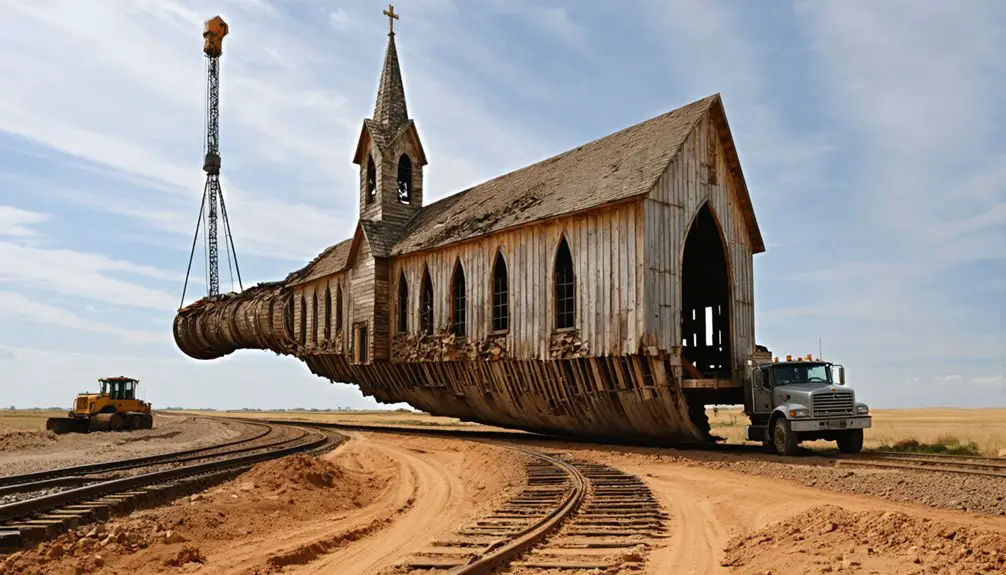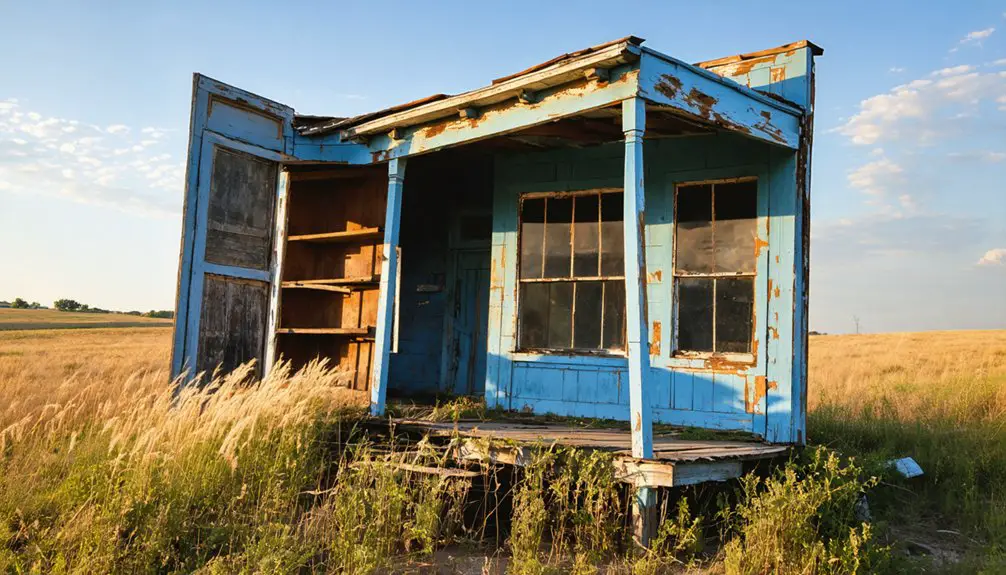You’ll find Defiance’s ghost town ruins in Woodson County, Kansas, where it once thrived with 500 residents before its dramatic fall in 1878. The town’s demise came after losing a heated county seat battle to Yates Center, compounded by chronic water shortages from unreliable springs. Most buildings were physically relocated to Yates Center, leaving only scattered foundations today. The story of Defiance reveals how natural resources and political power shaped Kansas frontier settlements.
Key Takeaways
- Defiance was a Kansas frontier town that peaked at 500 residents before becoming a ghost town due to water scarcity issues.
- The town lost its bid for county seat to Yates Center in 1875, triggering an exodus of residents and businesses.
- Buildings were physically relocated from Defiance to Yates Center, including the courthouse and private homes.
- By August 1878, Defiance was completely abandoned, with all core infrastructure moved to the new county seat.
- Today, only scattered foundations and overgrown ruins remain at the original Defiance site.
The Rise of Early Settlement in Woodson County
While Native Americans had long inhabited the region, Woodson County’s formal settlement began taking shape in 1856 when the first permanent white settlers arrived.
You’ll find that pioneers like David Cooper, Reuben Daniels, and John Coleman were among the first to establish homesteads across what would become distinct townships. These early settlers initially lived as squatters on Indian reserve lands until the government’s 1860 land sale at Fort Scott allowed them to formalize their claims.
The abundant coal and sandstone resources found throughout the county provided early settlers with crucial building materials and fuel sources. The terrain consisted of rolling prairie covering 90 percent of the land, with rich bottom lands along major waterways.
The county’s development accelerated with the formation of five original townships: Neosho Falls, Liberty, Owl Creek, Belmont, and Verdigris.
D.B. Foster’s trading post in Belmont and Peter Stevens’ store in Neosho Falls marked the beginnings of commerce, while newly established schools and local government helped transform the wilderness into organized communities.
Battle for the County Seat
In 1875, the town of Defiance found itself embroiled in a fierce battle for the Woodson County seat, competing against rival communities Neosho Falls, Kalida, and Yates Center.
The election rivalry reached a fever pitch as each town vied for the prestigious designation that would secure their economic future. You’d have witnessed intense campaigning and heated debates throughout the county as communities fought for votes. A major weakness for Defiance was its lack of water supply. Much like the Trading Post store that marked early commerce in Linn County, these competing towns understood a county seat designation would bring vital economic growth.
- The election campaigns turned especially contentious as supporters from each town rallied their neighbors.
- Abner Yates strategically offered land for a courthouse in Yates Center, swaying many voters.
- The final election results devastated Defiance’s hopes, leading to an exodus of residents and businesses.
The county seat battle’s outcome proved fatal for Defiance’s future, as many citizens packed up their belongings – and even their buildings – for the victorious Yates Center.
Water Resources and Town Survival
You’ll find that springs played a pivotal role in Defiance’s early settlement pattern, as pioneers sought reliable water sources to sustain their livestock and crops.
Despite the natural water features that first attracted settlers, the town couldn’t overcome the harsh realities of recurring droughts that plagued the region in subsequent years.
Similar to towns like Columbia, where destructive floods devastated the community, Defiance faced its own water-related challenges that impacted its survival.
The lack of sustainable water resources ultimately sealed Defiance’s fate, as farmers and merchants gradually abandoned their claims for more promising locations with dependable water supplies. This pattern of abandonment mirrored other Kansas towns like Minersville, where changing market demands for lignite coal mining led to population decline.
Springs Drive Settlement Patterns
As natural springs dotted the Kansas plains in the 1870s, these reliable water sources became critical determinants for settlement patterns and town survival.
You’ll find that spring significance shaped everything from military routes to town locations, including Defiance’s establishment. Water availability from these springs proved far more dependable than seasonal rivers, driving settlers to cluster their communities around these precious resources.
Similar to how the railroad bypass influenced the rise and fall of competing towns like Matson and Defiance, access to water shaped settlement success. Mulberry Creek and other waterways served as essential camping spots for travelers and settlers alike.
- Springs provided essential water for drinking, agriculture, and livestock needs
- Military trails and protection networks formed around reliable spring locations
- Towns with access to deeper, perennial springs showed greater resilience during drought periods
The distribution of freshwater springs helped determine transportation corridors, which directly impacted a settlement’s economic prospects.
You couldn’t sustain a town without good water, making spring locations the lifeblood of frontier development.
Drought Sealed Town’s Fate
While Defiance initially secured its position as the Woodson County seat, the town’s lack of reliable water sources quickly sealed its fate.
You’ll find that drought consequences in the 1870s devastated the settlement’s chances for survival, as both domestic needs and agricultural development suffered from severe water scarcity.
Similar to how Miller Arrowsmith established farmland near water sources, early settlers recognized the critical importance of reliable water access.
Without springs or “living water,” Defiance couldn’t compete with better-situated towns like Yates Center.
Similar to the nearby town of Khid/Kida’s decline, water shortages proved fatal to sustaining a viable community.
You can trace how the water crisis forced county officials to reconsider the seat’s location, ultimately leading to its relocation. Residents followed the water, moving their homes and businesses to more sustainable communities.
Even the courthouse was dismantled and rebuilt elsewhere. The harsh reality of frontier life meant that without reliable water resources, Defiance’s transformation into a ghost town was inevitable.
The Great Migration to Yates Center
As African Americans fled the post-Reconstruction South seeking opportunities in Kansas, you’ll find they contributed considerably to Yates Center’s growth by physically relocating buildings and homes from Defiance to establish new lives.
Their arrival shifted local political dynamics, as the growing black population established independent communities and governance structures despite ongoing discrimination.
These changes marked Yates Center as an important destination during the Great Migration, though the promised freedom and economic independence remained partially unfulfilled due to persistent racial barriers.
Moving Buildings and Homes
Following the historic 1876 county seat election that favored Yates Center, residents of Defiance and Kalida commenced an extraordinary migration that involved moving entire buildings to the new county seat.
The building logistics showcased frontier ingenuity as settlers transported structures over rough terrain using ox teams, preserving their community identity through physical relocation rather than starting anew.
- The courthouse from Defiance made the journey to Yates Center, establishing the new administrative center.
- Multiple private homes were hauled from Defiance, while Kalida’s hotel undertook a remarkable trek across the prairie.
- By August 1878, both towns stood empty as their core infrastructure found new life in Yates Center.
This mass relocation left Defiance and Kalida as ghost towns, with no significant structures remaining at their original sites.
Political Power Shift Impact
The physical relocation of buildings from Defiance to Yates Center coincided with a broader demographic transformation sweeping through Kansas in the late 1870s.
You’ll find that this period marked the beginning of the “Exoduster” movement, when thousands of African Americans fled the oppressive post-Reconstruction South seeking freedom and opportunity in Kansas.
This migration brought significant political empowerment to the region, as newly arrived Black residents established farms, businesses, and community institutions.
The demographic changes challenged existing power structures, particularly those held by Southern Democrats who’d previously controlled Black labor and votes.
While Defiance itself became a ghost town, the surrounding areas, including Yates Center, experienced shifts in local politics as African American citizens exercised their voting rights and participated in grassroots organizing, laying groundwork for future civil rights advances.
Physical Relocation of Buildings and Infrastructure

During Kansas’s westward expansion, relocating entire buildings became a common survival strategy for struggling frontier communities.
Moving buildings across the Kansas frontier helped pioneer communities survive as westward expansion reshaped settlement patterns.
You’ll find that building preservation often meant physically moving structures to new locations, especially when railroads bypassed original town sites. The relocation logistics required careful planning, with communities working together to dismantle or transport buildings using horse-drawn sleds and rollers.
- Structures were methodically taken apart to salvage materials like wood and nails for reassembly at new sites.
- Smaller buildings moved intact on sleds, while larger ones required complete dismantling.
- Communities coordinated efforts to prepare new foundations and plan transport routes.
This preservation strategy helped towns like Marshall and Columbia maintain their identity even as they relocated.
You’ll see evidence of these moves in places like Cheney, where buildings from the original Marshall settlement still stand.
Economic Factors Behind the Town’s Decline
While physical relocations helped some Kansas towns survive changing times, economic pressures proved too powerful for Defiance to overcome.
You’ll find that the town’s fate aligned with patterns seen across Kansas, where economic instability often spelled doom for small settlements. Like many of its contemporaries, Defiance suffered from fierce competition with neighboring towns for resources, commerce, and political influence.
The changing transportation landscape dealt additional blows – when major rail lines bypassed the settlement, it couldn’t sustain its commercial base. Without a diversified economy, the town became vulnerable to the boom-and-bust cycles that plagued single-industry communities.
Agriculture’s ups and downs, particularly during harsh economic downturns, accelerated the decline until Defiance could no longer maintain its population or business district.
Modern Day Remnants and Historical Significance

Visiting Defiance today, you’ll find little evidence of its once-ambitious frontier settlement beyond scattered foundations and overgrown ruins in the Kansas prairie.
As a cultural legacy of Kansas’s territorial development, this ghost town exemplifies how natural resources shaped frontier success and failure. The brief rise and fall of Defiance during the 1870s county seat wars offers insights into the challenges pioneers faced.
Through Defiance’s rapid boom and bust, we glimpse how pioneers’ dreams lived and died by the land’s precious resources.
- The town peaked at 500 residents before water scarcity led to its downfall
- Historical significance centers on its role in Woodson County’s heated county seat competition
- Physical remnants are limited to deteriorated foundations and possible cemetery stones
While few tangible traces remain, Defiance’s story lives on through local histories and ghost town tours, preserving its place in Kansas’s settlement narrative.
Frequently Asked Questions
What Native American Tribes Originally Inhabited the Defiance Area?
You’ll discover the tremendous tribal heritage of the Kiowa, who dominated this region with their cultural significance, while the Kickapoo and Miami peoples later moved through during forced western migrations.
Were There Any Notable Crimes or Lawlessness in Defiance’s History?
You’ll find records of political lawlessness during county seat wars in 1873-74, with contested elections and vote tampering, but no specific violent crime incidents or major law enforcement confrontations are documented.
What Was the Population of Defiance at Its Peak?
Like a shooting star that briefly illuminates the prairie sky, you’d find that the peak population reached 500 people in the 1870s, before historical census records show a dramatic population decline.
Did Any Famous Historical Figures Ever Visit or Stay in Defiance?
You won’t find records of any famous visitors to this locale. While the town held historical significance during county seat battles, it primarily attracted local figures like Abner Yates, not nationally-known personalities.
Are There Any Documented Paranormal Activities in Defiance’s Abandoned Structures?
You won’t find any documented ghost sightings or paranormal activities in the abandoned buildings. While Kansas has many recorded hauntings, no official investigations or verified supernatural reports exist for this location.
References
- https://cityofyatescenter.com/history/
- https://www.youtube.com/watch?v=MD6VGpFNfsg
- https://octa-trails.org/wp-content/uploads/2023/05/Ellis-Uniontown-and-Plowboy–-Potawatomi-Ghost-Towns.pdf
- https://www.youtube.com/watch?v=alC1wDdSVvg
- https://en.wikipedia.org/wiki/List_of_ghost_towns_in_Kansas
- https://www.revitalizeyc.com/ycmurals/historicalmap
- http://www.kancoll.org/books/cutler/woodson/woodson-co-p1.html
- https://legendsofkansas.com/woodson-county-kansas/
- https://www.ksgenweb.org/archives/allen/history/1901/582.html
- https://www.ksgenweb.org/archives/allen/history/1901/



